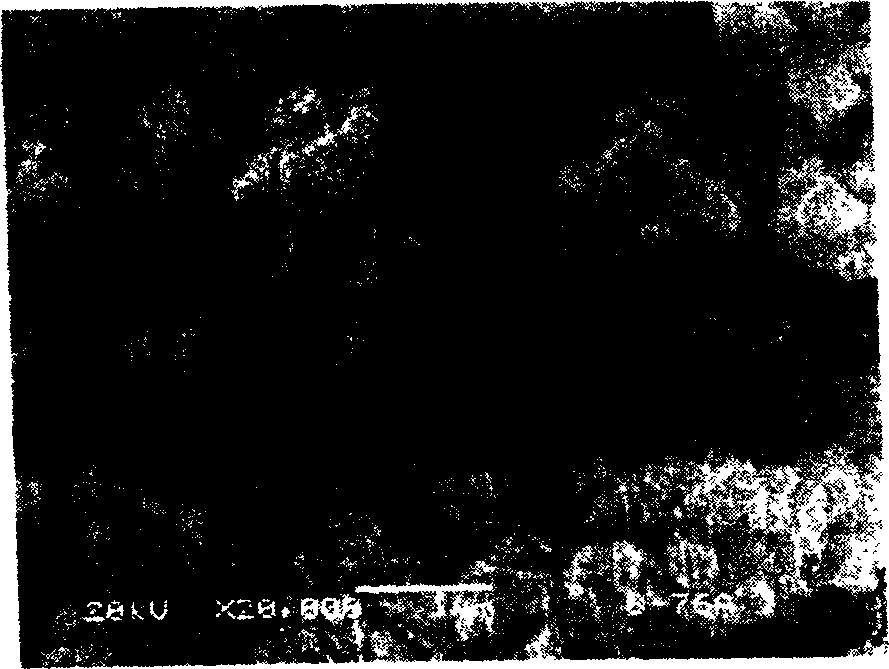Method for producing WC-Fe composite powder of ultra fine grain by tungsten alloy scrap
An ultra-fine grain, tungsten alloy technology, applied in the field of powder metallurgy, can solve the problems of uniform mixing of elemental refractory composite powder, reducing the metallographic uniformity of cemented carbide products, and difficult to maintain consistent grain size, and achieve advanced technology. , The effect of uniform grain, high strength and hardness
- Summary
- Abstract
- Description
- Claims
- Application Information
AI Technical Summary
Problems solved by technology
Method used
Image
Examples
Embodiment 1
[0016] In this embodiment, the waste hard alloy top hammer (containing WC: 92%, cobalt about 8%) is recycled to produce 10% cobalt-containing ultra-fine grained tungsten carbide-cobalt composite powder as an example:
[0017] A. Oxidation roasting: Put 2000g of the waste cemented carbide top hammer crushed to <50mm and washed to remove impurities in a heat-resistant alloy steel boat, and then sent to the oxidation furnace. Roasted for 5 hours under the condition of air mixed gas, 2254g of cobalt tungstate-tungsten trioxide mixture is obtained (about 90g of unoxidized waste cemented carbide residue is removed); the mixed gas flow rate: air 500L / hour, oxygen 150L / hour;
[0018] B. Crushing and grinding: After crushing the obtained 2254g mixture block material to less than 5mm, place it in a ball mill, add 12kg cemented carbide balls, and grind into a powder that has passed through a 40 mesh sieve.
[0019] C. Wet grinding ingredients: Put the above powder together with 14.3g of van...
Embodiment 2
[0025] In this embodiment, 1000 g of high-density tungsten alloy waste containing 92% W, approximately 8.0% of nickel and iron is used as raw material to produce ultrafine tungsten carbide-nickel and iron composite powder containing 10.0% of nickel and iron as an example:
[0026] A. Oxidation roasting and B pulverization and grinding are the same as in Example 1, to obtain 1240 g of nickel tungstate, iron tungstate-tungsten trioxide composite powder;
[0027] C. Wet milling ingredients: the above composite powder together with 72g of nickel oxalate, 8.0g of vanadium oxide, 5.0g of chromium oxide, and 98g of carbon black powder are sent to a ball mill for 66 hours of wet milling, and then dried for use;
[0028] D. The reduction treatment is also the same as in Example 1;
[0029] E. Carbon preparation: send the powder obtained from the reduction treatment together with 33.5g of carbon black powder into the ball mill for 72 hours of wet grinding, and then dry for use;
[0030] The...
PUM
| Property | Measurement | Unit |
|---|---|---|
| crystal size | aaaaa | aaaaa |
| particle size | aaaaa | aaaaa |
Abstract
Description
Claims
Application Information
 Login to View More
Login to View More - R&D
- Intellectual Property
- Life Sciences
- Materials
- Tech Scout
- Unparalleled Data Quality
- Higher Quality Content
- 60% Fewer Hallucinations
Browse by: Latest US Patents, China's latest patents, Technical Efficacy Thesaurus, Application Domain, Technology Topic, Popular Technical Reports.
© 2025 PatSnap. All rights reserved.Legal|Privacy policy|Modern Slavery Act Transparency Statement|Sitemap|About US| Contact US: help@patsnap.com

